Speak to any suckler or drystock farmer, or indeed mart drovers, and they will universally agree that stock have increasingly gotten more difficult to manage.
The part-time nature of drystock farming, with less handling and moving of stock, are the main contributing factors.
Dairy farmers have the distinct advantage of developing a relationship with stock early on in life through bucket-rearing calves, though this may diminish as auto feeders come in to play.
While there were already decent facilities on-farm for handling stock, Michael Cunnane, a suckler farmer just outside the village of Aghamore, Co Mayo, wished to further simplify handling and improve the safety around it.
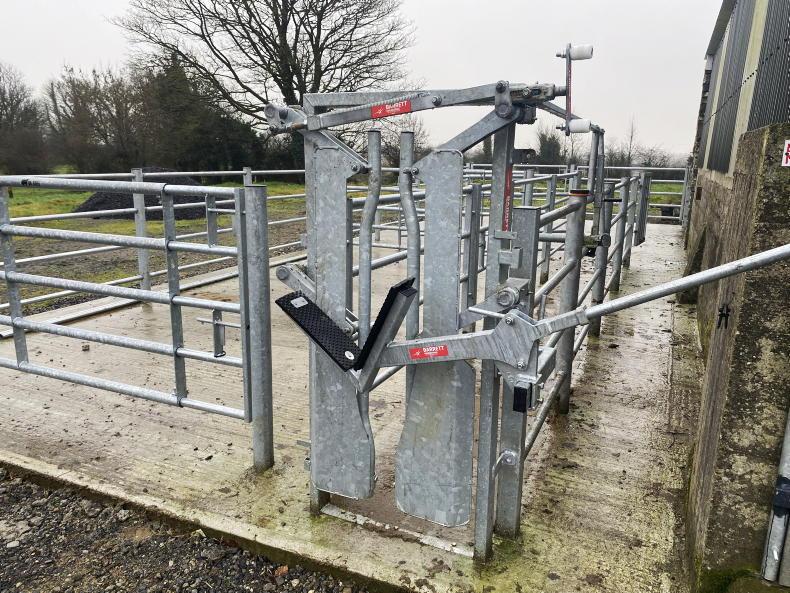
The head scoop cuts out the difficulty in catching cows. Note the pedestrian access between the crush and the wall.
His father, Michael Snr, explained: “We had crushes on-farm here that worked okay in the past. But with suckler cows bigger now and on the wilder side, you need good facilities for them.’’
Michael Jnr, therefore, decided to complete a bespoke handling unit for the suckler herd, beside an older roofed handling area.
A large concrete pad was poured, with the box and round steel upright posts for the outer barriers, internal gates and crush set in to the floor. The posts come with four pre-drilled holes to slide in heavy-duty tubular steel lengths through for the outer barriers.
Internal set up
Like many crushes around farmyards, the older crushes on the Cunnane farm were built with one side against a wall.
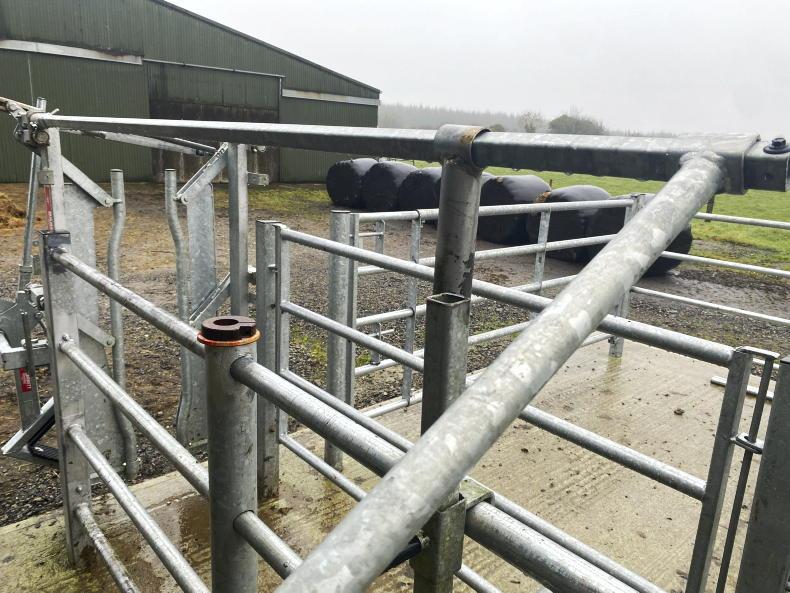
Pushing downwards on the handle closes the head gate around the animals neck, locking it in place.
To give safer access for animal handling, Michael decided to move the crush out from the wall of the adjacent shed. The crush now has access for pedestrians either side, with the side running along the wall blocked from animal access.
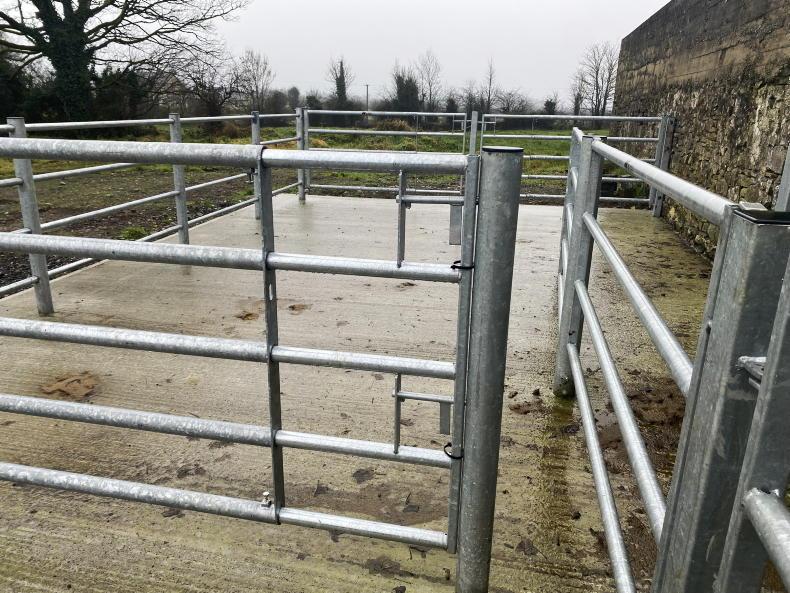
Safety escapes are fitted between the pens, with safety a key focus in designing the yard.
While this side is fixed with tubular steel lengths running through round posts, the side facing the animal area is made up of three large gates and a smaller pedestrian gate.
Should it happen that an animal goes down in the crush, the gate can be opened to give them room to get up.
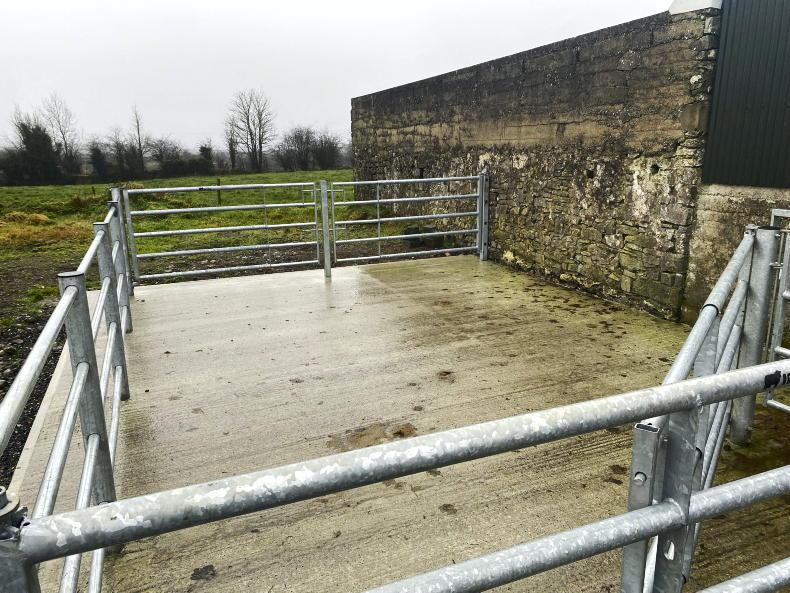
The swinging gate seen on the right funnels cattle in to the crush from the rear pen. Gates to the rear will allow stock to enter from the field.
An anti-backing bar has been fitted just above the pedestrian gate for safety. Cattle are funnelled in to the crush by a swinging gate, hung off the end post. Safety was the prominent theme when designing the area, with pedestrian escapes located at the entry beside the headstock and an additional escape on the dividing gate that splits the handling area in two.
Skulling gate
Michael Jnr had a skulling gate already on the farm which he transferred over on to the new crush. Manufactured by Niall Barrett Engineering, the gate can be operated from behind the backing bar, with the handle lowered to close the gate on the animal’s neck.
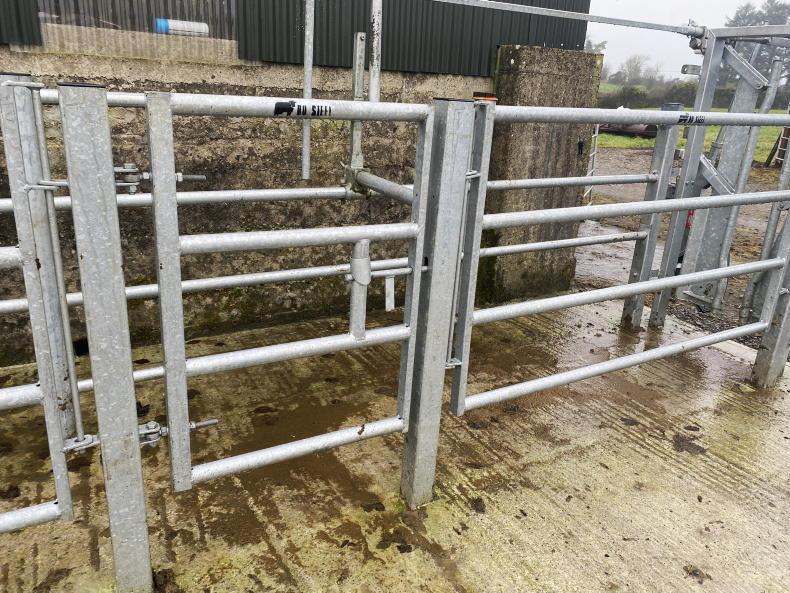
A pedestrian gate behind the backing bar allows for safe access for scanning, breeding, etc.
Once pressure is released by lifting the handle, the spring-loaded skulling gate widens out to allow release. The spacing between the two sides of the gate can be altered by winding a handle in or out for different animal sizes (cows, weanlings).
All wearable parts of the gates are fitted with grease nipples to prevent excess wear and tear, and the gate is coupled with a ratcheted head scoop.
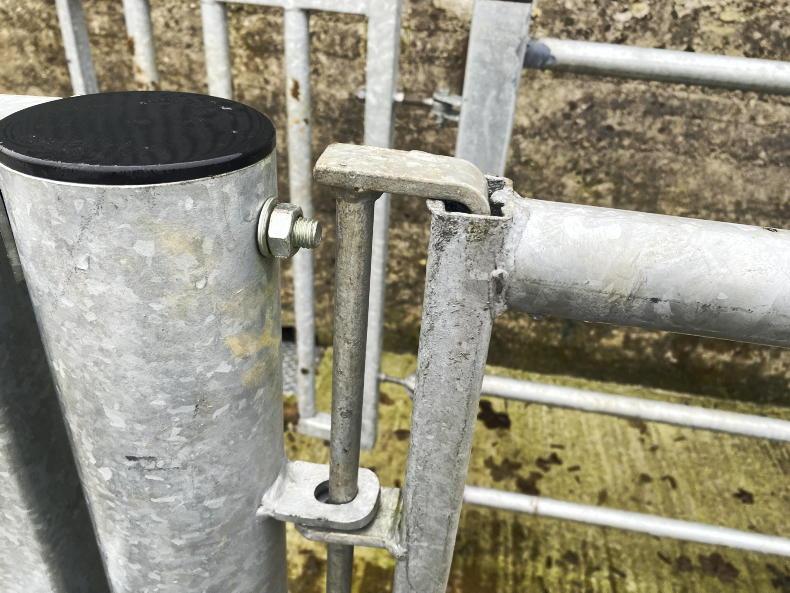
The gates on one side of the crush can be opened in either direction by lifting one of the pins at the end of the gate.
Catching animals for dosing or bolusing is a difficult task on any farm, even with a skulling gate fitted. The head scoop is a safe and easy means of catching cows to complete tasks, in Michael Jnr’s eyes.
Michael has some additional gates to hang, to allow for one person to move cattle between the cattle handling area and the slatted shed in the yard, but having trialed the set up already, he is extremely pleased with how it has worked.
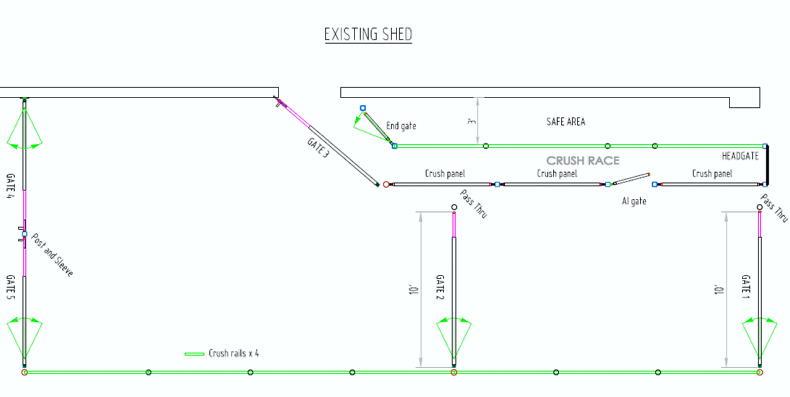
Layout of the handling unit on the Cunnane farm. \ Bo Steel
The plan for the future would be to roof the area and add lighting for working in wet weather and in the evenings, such as he has done to the older handling crush.
Michael will also knock through the wall in to the older handling unit in the coming months, to allow for additional space.
Speak to any suckler or drystock farmer, or indeed mart drovers, and they will universally agree that stock have increasingly gotten more difficult to manage.
The part-time nature of drystock farming, with less handling and moving of stock, are the main contributing factors.
Dairy farmers have the distinct advantage of developing a relationship with stock early on in life through bucket-rearing calves, though this may diminish as auto feeders come in to play.
While there were already decent facilities on-farm for handling stock, Michael Cunnane, a suckler farmer just outside the village of Aghamore, Co Mayo, wished to further simplify handling and improve the safety around it.

The head scoop cuts out the difficulty in catching cows. Note the pedestrian access between the crush and the wall.
His father, Michael Snr, explained: “We had crushes on-farm here that worked okay in the past. But with suckler cows bigger now and on the wilder side, you need good facilities for them.’’
Michael Jnr, therefore, decided to complete a bespoke handling unit for the suckler herd, beside an older roofed handling area.
A large concrete pad was poured, with the box and round steel upright posts for the outer barriers, internal gates and crush set in to the floor. The posts come with four pre-drilled holes to slide in heavy-duty tubular steel lengths through for the outer barriers.
Internal set up
Like many crushes around farmyards, the older crushes on the Cunnane farm were built with one side against a wall.

Pushing downwards on the handle closes the head gate around the animals neck, locking it in place.
To give safer access for animal handling, Michael decided to move the crush out from the wall of the adjacent shed. The crush now has access for pedestrians either side, with the side running along the wall blocked from animal access.

Safety escapes are fitted between the pens, with safety a key focus in designing the yard.
While this side is fixed with tubular steel lengths running through round posts, the side facing the animal area is made up of three large gates and a smaller pedestrian gate.
Should it happen that an animal goes down in the crush, the gate can be opened to give them room to get up.

The swinging gate seen on the right funnels cattle in to the crush from the rear pen. Gates to the rear will allow stock to enter from the field.
An anti-backing bar has been fitted just above the pedestrian gate for safety. Cattle are funnelled in to the crush by a swinging gate, hung off the end post. Safety was the prominent theme when designing the area, with pedestrian escapes located at the entry beside the headstock and an additional escape on the dividing gate that splits the handling area in two.
Skulling gate
Michael Jnr had a skulling gate already on the farm which he transferred over on to the new crush. Manufactured by Niall Barrett Engineering, the gate can be operated from behind the backing bar, with the handle lowered to close the gate on the animal’s neck.

A pedestrian gate behind the backing bar allows for safe access for scanning, breeding, etc.
Once pressure is released by lifting the handle, the spring-loaded skulling gate widens out to allow release. The spacing between the two sides of the gate can be altered by winding a handle in or out for different animal sizes (cows, weanlings).
All wearable parts of the gates are fitted with grease nipples to prevent excess wear and tear, and the gate is coupled with a ratcheted head scoop.

The gates on one side of the crush can be opened in either direction by lifting one of the pins at the end of the gate.
Catching animals for dosing or bolusing is a difficult task on any farm, even with a skulling gate fitted. The head scoop is a safe and easy means of catching cows to complete tasks, in Michael Jnr’s eyes.
Michael has some additional gates to hang, to allow for one person to move cattle between the cattle handling area and the slatted shed in the yard, but having trialed the set up already, he is extremely pleased with how it has worked.

Layout of the handling unit on the Cunnane farm. \ Bo Steel
The plan for the future would be to roof the area and add lighting for working in wet weather and in the evenings, such as he has done to the older handling crush.
Michael will also knock through the wall in to the older handling unit in the coming months, to allow for additional space.








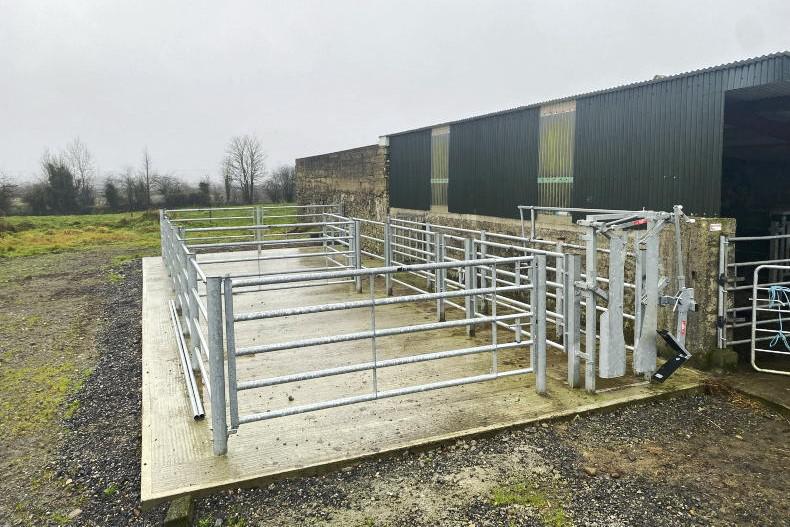




 This is a subscriber-only article
This is a subscriber-only article










SHARING OPTIONS: